These six little dinos, sculpted by the Carnegie Collection’s own Forest Rogers, may look pretty dated today; but they manage to blend old and new aspects of science to produce a charming set as a whole.
Safari ltd. stands as one of the giants of educational, scientifically accurate dinosaur & animal toys today; but it’s easy to forget the company didn’t start out this way. For the first decade of their existence, Safari ltd. served as primarily as a distributor for other established toy lines, including Invicta, AAA, and Schleich – the latter of which, interestingly, was among the first (alongside Bullyland) to produce higher-end painted dinosaur toys. Schleich’s and Bullyland’s endeavors would help inspire Safari to start pursuing their own unique lines of dinosaur toys. In the year 1990, Safari ltd. was only a year or two into their now-legendary Carnegie Collection, while their broader Wild Safari series of toys had yet to begin. Another line Safari started at this time was the Authentics Habitat Collection, a series of minifigures sold individually or in small packaged sets. Although this collection hasn’t retained the fame of the Carnegie Collection, nor remained active and updated like Wild Safari, these little figures arguably set the foundation for the Toobs line of minifigures; thus their legacy and history lives on today.
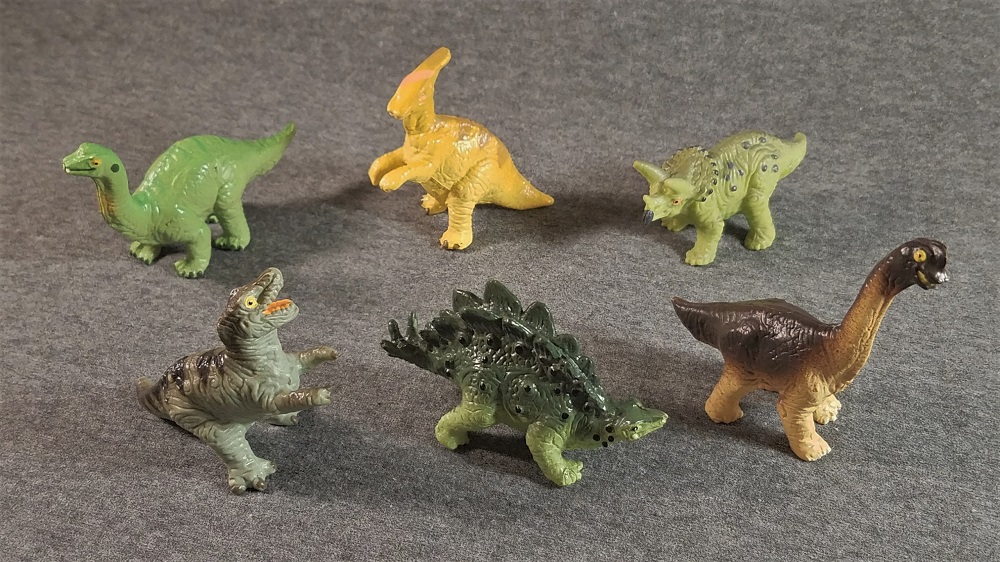
Among the first three Authentics sets released was Dinosaurs I, featuring six little dinos sculpted by the Carnegie Collection’s own Forest Rogers. Although similar in some aspects to Rogers’ larger dinosaur sculpts, each of these Authentics minifigures was ultimately a wholly unique sculpt. The line’s influence on Safari’s later Toobs line is especially notable in this set: most of these little dinosaurs were directly referenced for the original Dino Toob, which remains in production today. In the following years, a second and third set of Authentics Dinosaurs would also be produced, Perhaps the only Authentics sets to have true sequel releases. Together these three Dinosaur sets went in and out of production up through the mid-2000s; the sets were distributed (ironically) by Schleich in 1993, and the first set’s molds were even used for an eraser set. The Authentics were also re-labeled as Carnegie Minis as late as 2006, sold in small packs of three figures. By the 2010s, the Authentics line appeared to finally go extinct; but for nearly twenty years these little dinosaurs hung on.
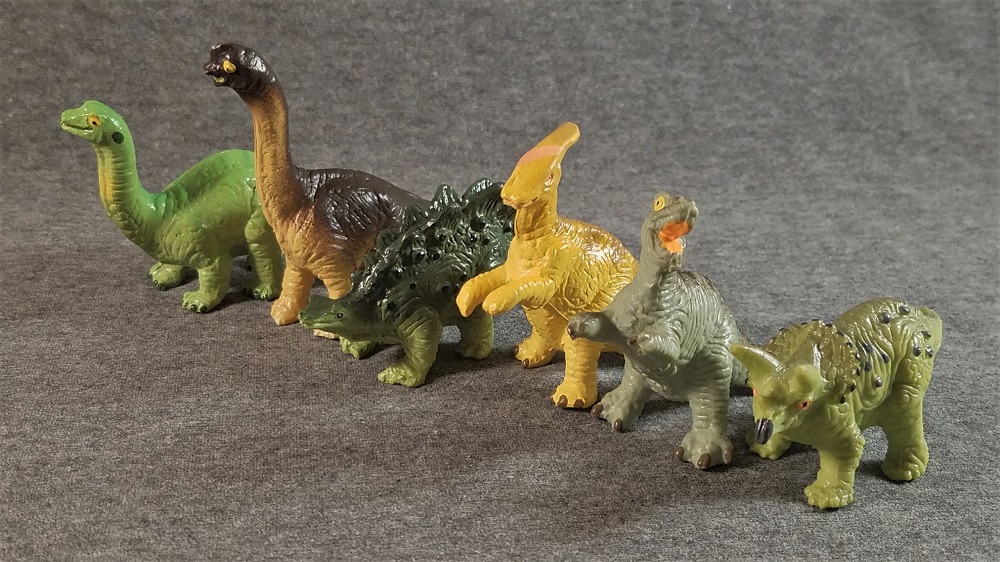
My first Authentics Dinosaurs consisted of two individual figures –Tyrannosaurus and Stegosaurus – gifted to me sometime around the year 2000. These figures average around 2.5-3 inches long, and roughly 1.75-2 inches tall. All of the figures are made of a relatively soft plastic, firm but slightly pliable, akin to the Carnegie models from the same time. Over the years these figures, which began as individually hand-painted items, would undergo various subtle changes in coloration as well as slight sculpt revisions. At some point in time, these figures also became victims of bootlegging from Chinese factories. To my knowledge, no comprehensive records have been made of the differences between the various official and unofficial releases; collectors may be advised to check any copies of their own to determine which traits seem more legit than not.
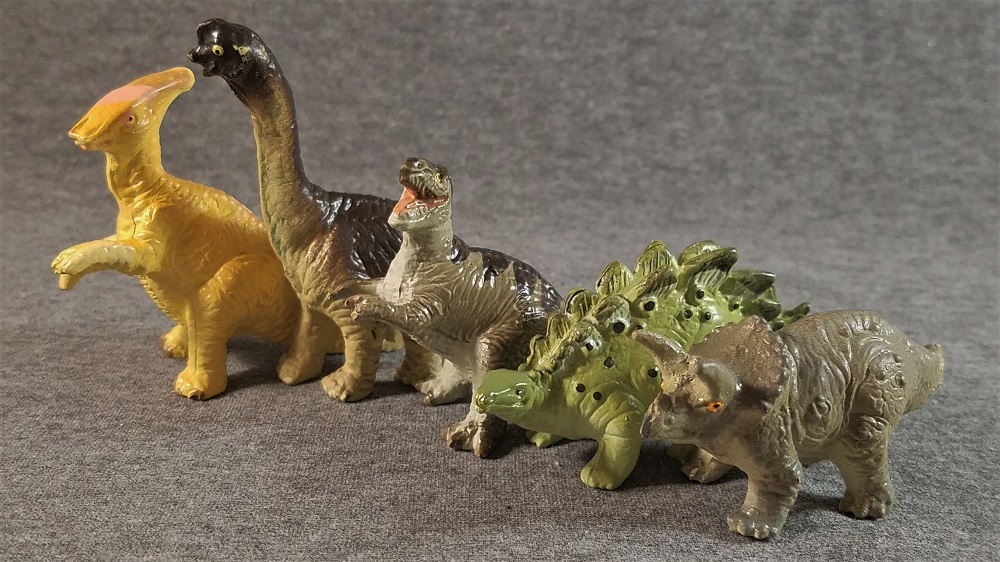
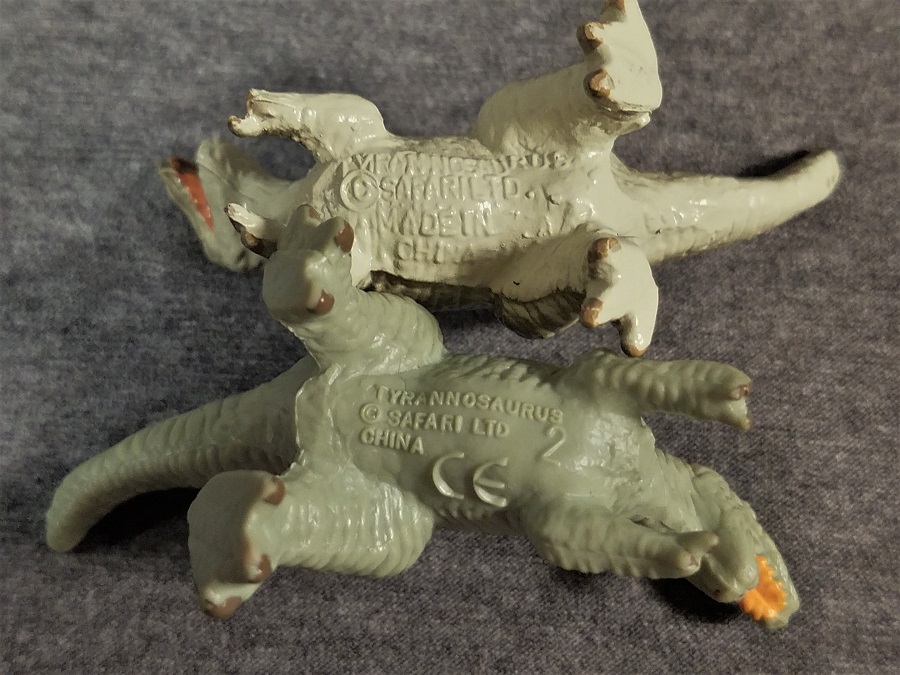
Tyrannosaurus, the sole theropod of the Dinosaurs I set, represents the broad aesthetics of the set well. The dinosaur is posed rearing back, mouth open wide in a classic roaring display. The figure is generally round and plump-looking, with stylized anatomical features that are more appealingly friendly than rigidly scientific. The head is relatively large, with similarly large teeth; ear holes and brow ridges are noticeable, but the eyes are over-sized for visibility on the toy. Tyrannosaurus’s arms are also quite large on this toy, posed reaching straight out with two stubby fingers. The posture of the figure leans into a tripod stance, balanced on rather stumpy legs and tail. Skin texture consists mostly of deep, wrinkly striations, with a few patches of irregular pebbly scales in random spots on the body.
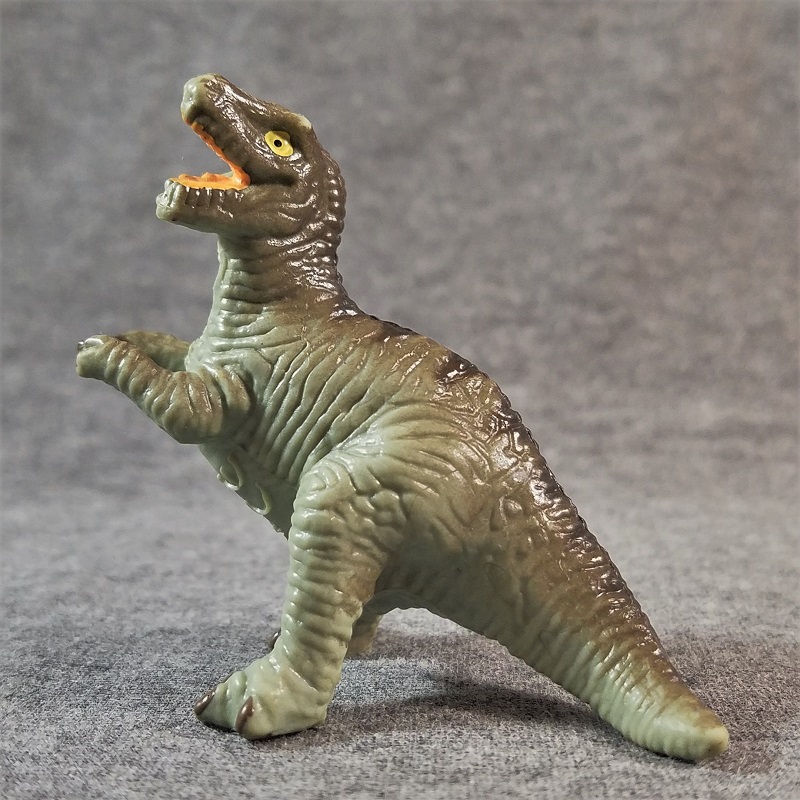
Since the Authentics figures went through numerous releases (and possible knockoffs), each copy of a figure has the potential to be unique. I have a second copy of the Tyrannosaurus in my collection, which features multiple distinctions from the first. Although virtually identical in size, my second Tyrannosaurus appears to have slightly refined proportions, including smaller arms, pointier toes, and a more defined skull shape. The teeth and skin textures, conversely, are less pronounced, and a glossier finish is applied over the body. Coloration on both figures is simple gray tones, shifting light to dark from the underside to the top, with large diamond-shaped stripes on the back and tail. On my first figure, these stripes are blended into the gradient of the main gray tones; on the second, the stripes have a harder application, and extend onto the snout. The second figure is generally more brown in coloration, and the yellow eyes and orange mouth appear painted less sloppily. Perhaps the most notable difference, however, comes underneath the figures. My first Tyrannosaurus is engraved on its belly with the genus name and full copyright information from Safari ltd, printed in small but legible writing. My second Tyrannosaurus features most of the same information, but the printing is larger and surprisingly less legible, running words into each other and blurring with the skin texture. No dates are printed on either figure, so I’m not sure which version was produced first; but each figure retains that classic quasi-retro style seen in many toys and art of the time.
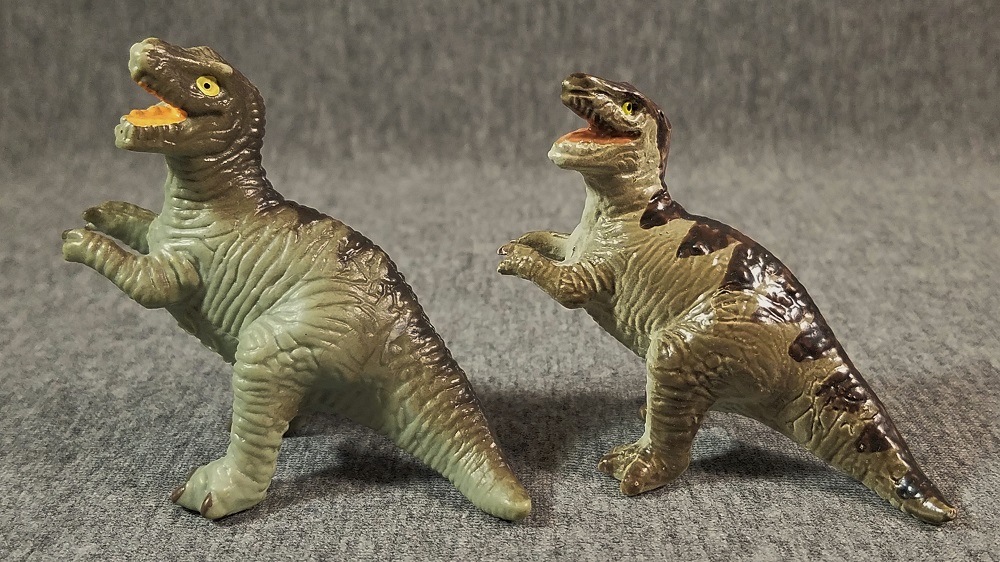
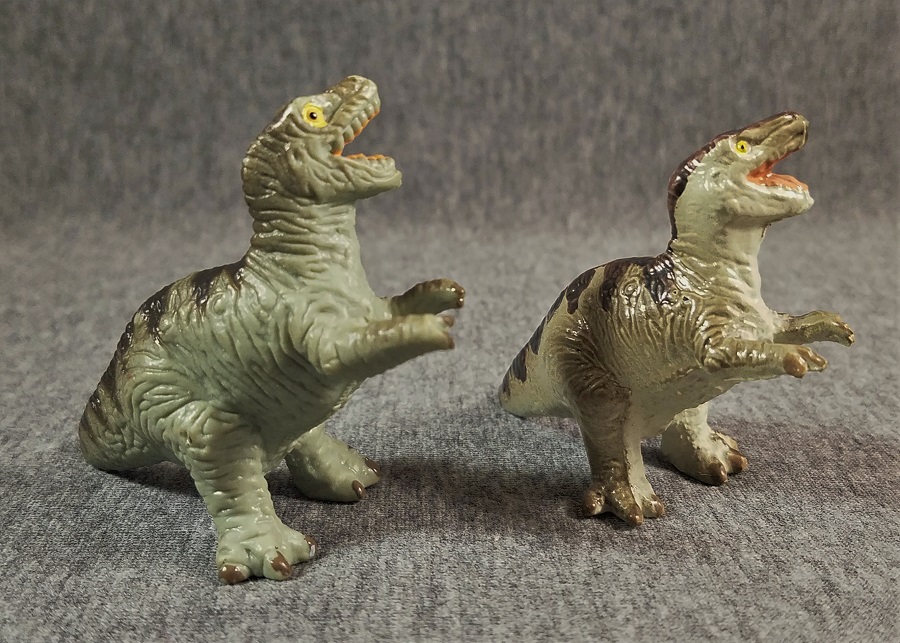
The second figure I acquired from the set, the Stegosaurus, leans even further into the retro aesthetics of 1950s artwork of the animal, striking a pose very similar to Forest Rogers’ larger Carnegie sculpt of the same genus. Legs are short and stumpy, and the body is tall and sloped in the spine. The head is flat and lizard-like, but perky and bright-eyed; this isn’t a totally stereotypical sluggish reptile. The two rows of iconic dorsal plates run in alternating order from the base of the neck to the end of the tail, enhancing the arched appearance of the back and culminating in four upwards-pointing tail spikes. All edges are rounded off and rubbery for safe handling/playing. Skin texture is an even more irregular mix of wrinkles and scales, with additional large, round scales protruding in clusters across the body.
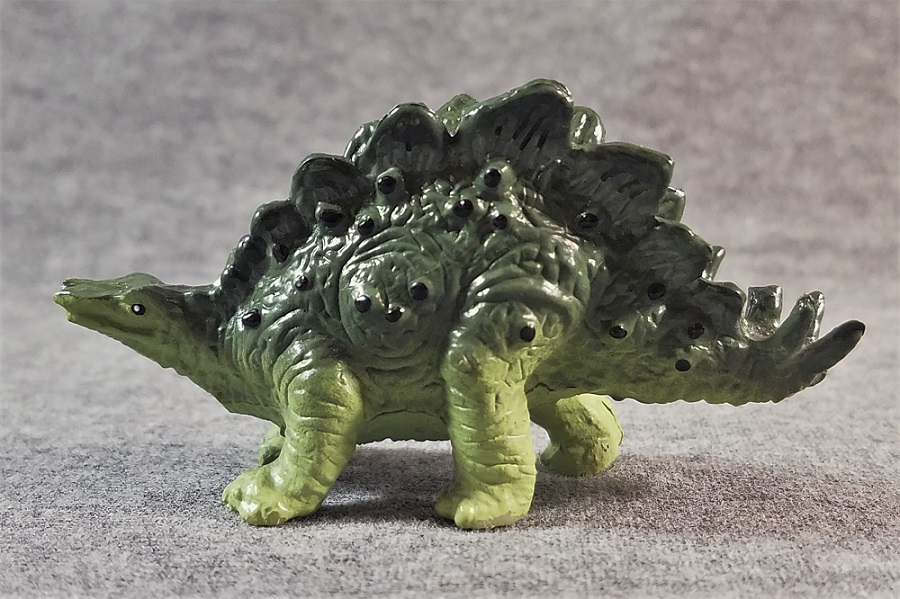
Like the Tyrannosaurus, individual copies of the Stegosaurus can have their own unique features. My own two copies of the figure are quite noticeably different in coloration; the first is a dark forest green on the upper body with a light lime green underneath, whereas the second is almost completely light green with only faint olive highlights on the flanks and plates. Both figures have subtle grayish washes on the plates, and the large round scale clusters are dotted in glossy solid black (or maybe charcoal gray). The eyes on both figures are neatly painted black with white reflection dots, giving the figures a rather perky appearance despite their dumpy stature. Details in the sculpt vary slightly too; the second figure has a lower-arched back, and the feet and head have more refined shapes.
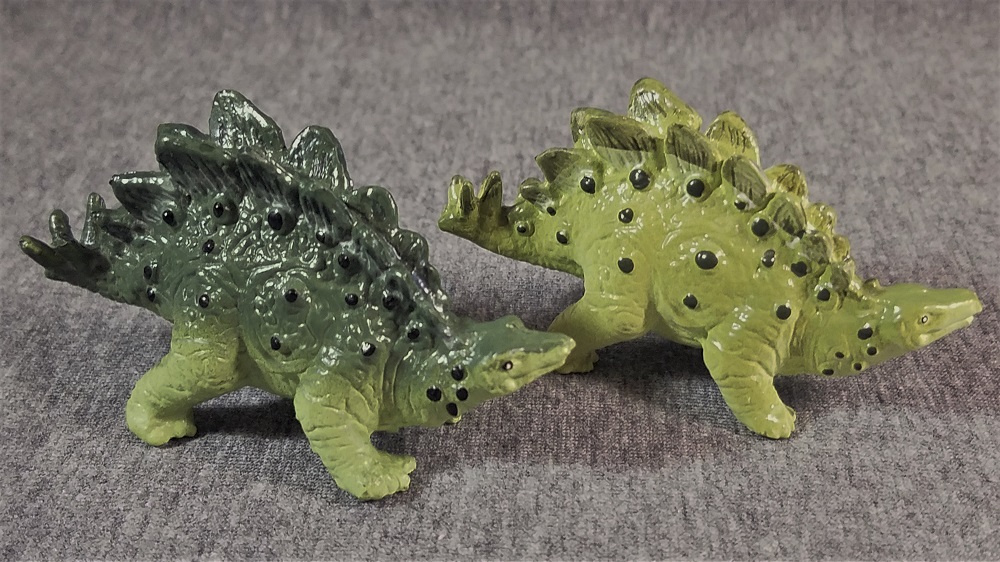
There are three figures each representing the Jurassic and Cretaceous periods in the Authentics Series 1. Stegosaurus is accompanied by two sauropods for the Jurassic, those being the classic Brachiosaurus and Brontosaurus – yes, you read that right, Brontosaurus is the name engraved on the underside. This little longneck stands with its head and neck held straight up, its stumpy tail held horizontally off the ground. While not quite a lumbering tail-dragger, this plump dinosaur looks like it would be at home in the era of the 1970s when the full “renaissance” paleoart trends had yet to permeate most of the media. The face is rather smiley-looking with its wide mouth – a lot of the figures in this set have a certain cheery cuteness to them – and a hint of high nostrils is evident when inspecting the top of the head. A slight wattle also seems to run the length of the throat. Wrinkly texture is applied to the skin, but slightly less obviously so than some of the other figures.
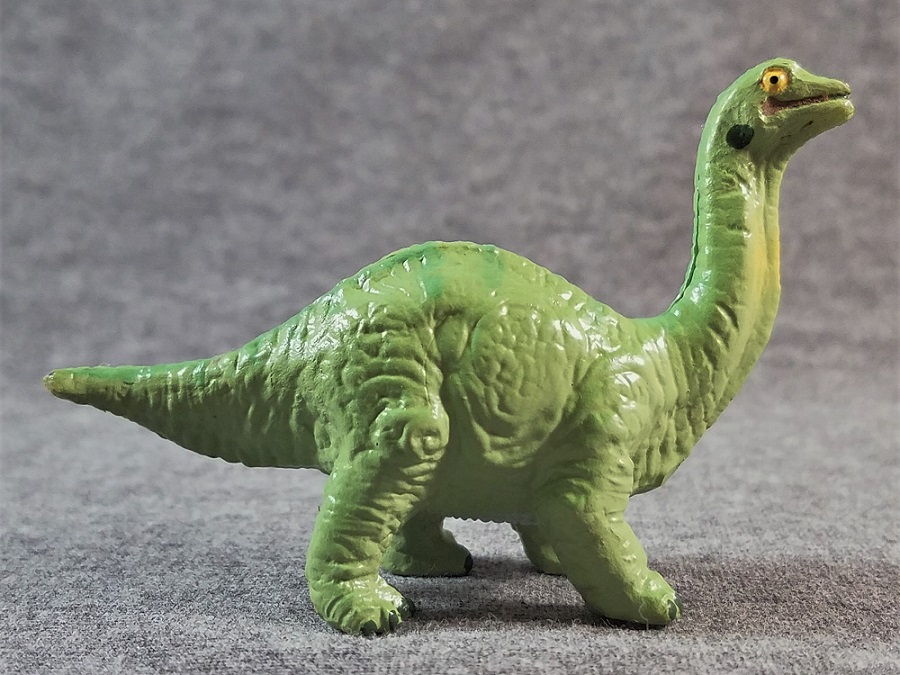
Unlike the rest of my figures for this set, I don’t have two copies of the Brontosaurus to compare between. My single figure seem generally well-sculpted, goofy smiley face aside. Lime green is the predominant color, with faint striping down the back and a soft yellow patch on the throat. The wide, round eyes are also yellow in color, and there appear to be dark green ear holes or eye spots at the back on the head. All five toes on each foot are individually painted, and the standard name and copyright information is engraved on the stomach.
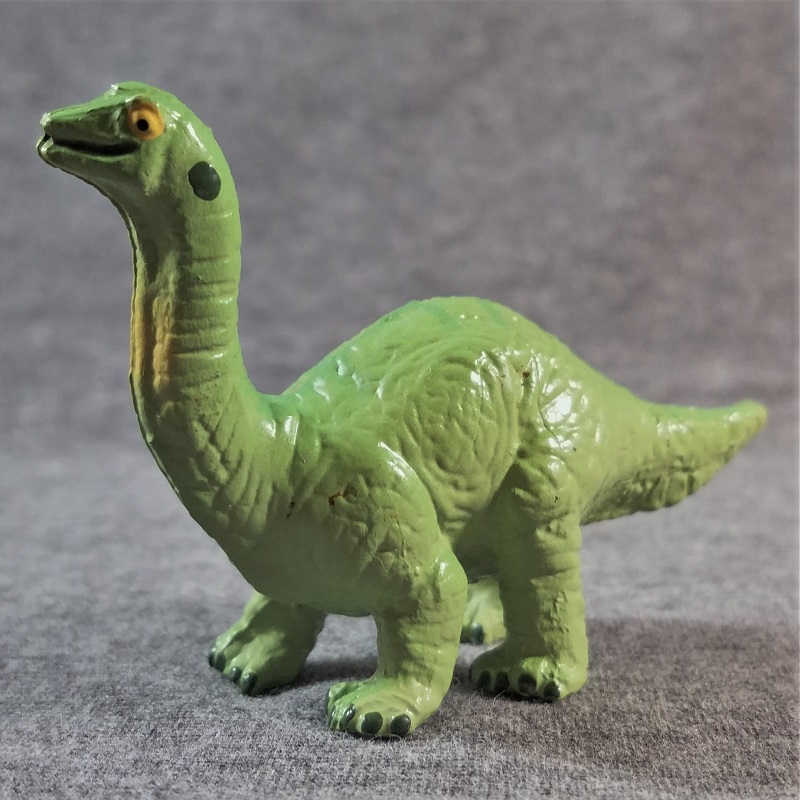
Brontosaurus is roughly the same height as the other figures in this set, but Brachiosaurus, perhaps unsurprisingly, stands a good head taller than any of the rest. Head held high, with a deep torso supported by robust legs, this miniature giant can easily remind one of Forest Rogers’ mighty sculpt for the Carnegie Collection from the same general time, or to iconic media portrayals such as Jurassic Park and even the later Disney’s Dinosaur. The creature’s neck is displayed swayed to one side, head tilted slightly with another bright-eyed big grin as if this gentle giant might be missing a few gastroliths. Silly face aside, however, even at this scale the figure does a good job conveying an imposing animal of originally great size.
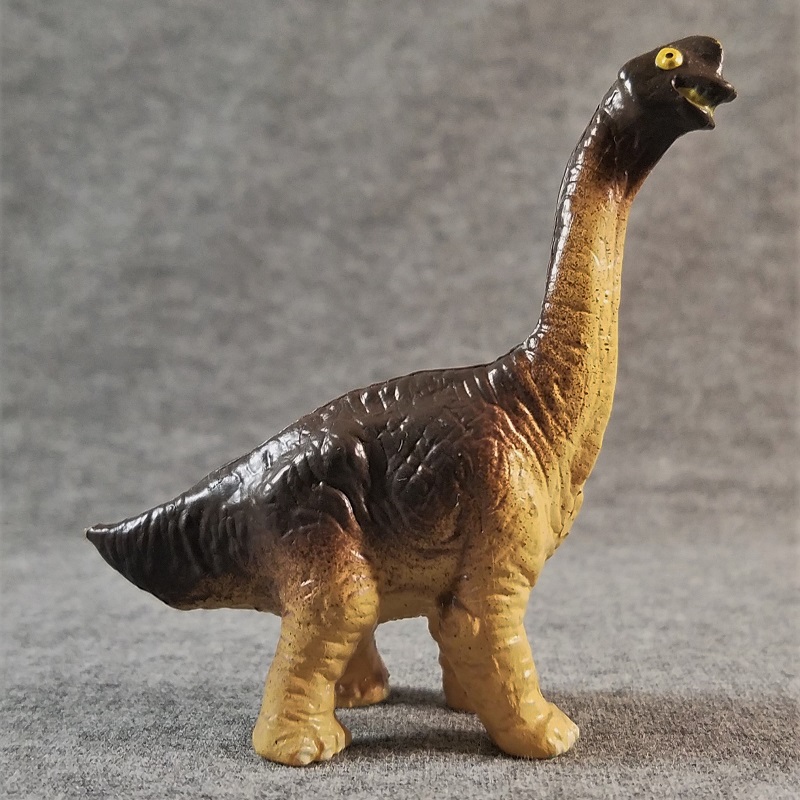
The two copies of Brachiosaurus in my possession both feature full name and company engravings on their bellies, although only one appears to bear the CE mark. Both figures are colored in simple dark brown and dirty yellow/tan countershading, with some variation of saturation between the two figures. The toes are all painted white individually, and the faces feature bright yellow eyes and mouths; my second of the two is looking a little worse for the wear, but appears to have slightly more refined sculpting and neater painting to its head.
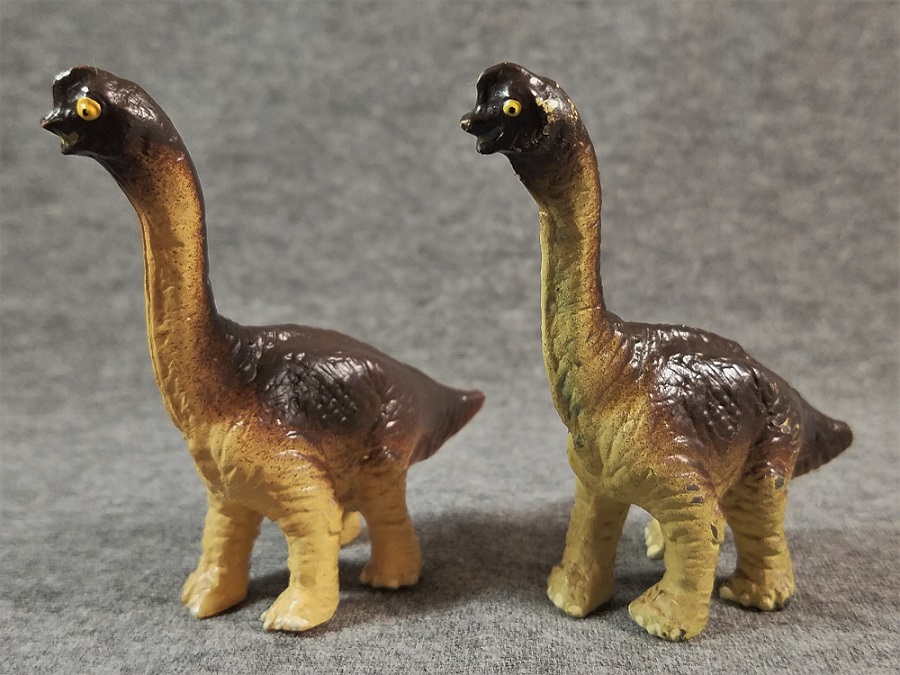
The Cretaceous genera bear a little more diversity. Parasaurolophus provides the set a hadrosaur and a second bipedal genus, at as depicted for the time. Another superficially similar sculpt to its larger Carnegie counterpart, the Parasaurolophus is posed in a raised tripod stance, with forearms held out forward. The figure looks like it is somewhere in between rearing and squatting position, with a low-slung belly and short legs tilted back as if to rest the animal’s weight on the tail instead (also very shortened as is the style for this set). While not as “smiley” as some of the other dinosaurs, this Parasaurolophus still has a distinctly sculpted mouth line and eye sockets, with large nostrils at the fron end of a bill which connects to a broad, flattened crest with webbed skin on the back of the neck. This isn’t the most graceful this hadrosaur has been portrayed, but its a fairly lively figure for its stylized dumpiness.

Differences between the two copies of Parasaurolophus in my collection are less notable than most of the other Series 1 Authentics I’ve handled. Both figures have nearly identical wrinkly skin and anatomical features, with little change of note besides the manner of engraving the company and genus information on the stomach. Both figures are a saturated yellow in color, with muddy brown diamond patterns running along the back and a strangely asymmetric stripe of pink on top of the middle of the crest. The eyes and mouth are also pink; the toes are individually painted dark brown (no highlights to the hands). This is perhaps the most brightly colored member of the set.
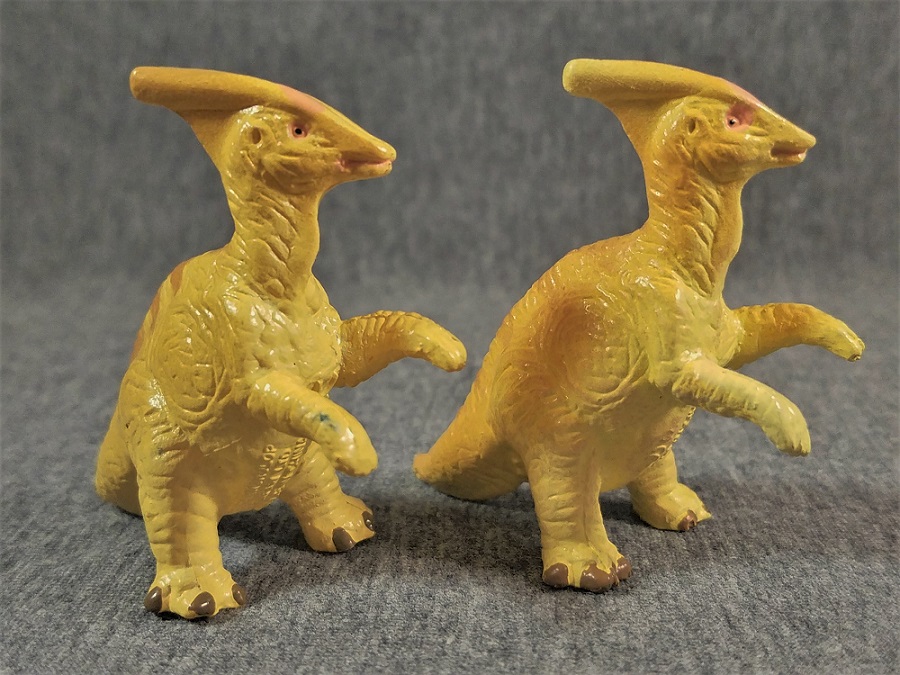
The sixth and final member of the Authentics set is Triceratops,the classic contemporary and rival to Tyrannosaurus, rounding out the set appropriately. Although no less stumpy and round than the rest of the set’s dinosaurs, Triceratops keeps its head and tail held high, with its four blocky legs lifting the belly well off the ground. The three distinctive horns are fairly straight and pointy (but not too pointy), and the round frill is adorned with a lining of large scales or spikes. Additional large scales, as seen on many of the others dinosaurs, are arranged in irregular patterns on the flanks of the body, which has the same heavy wrinkly skin texture.
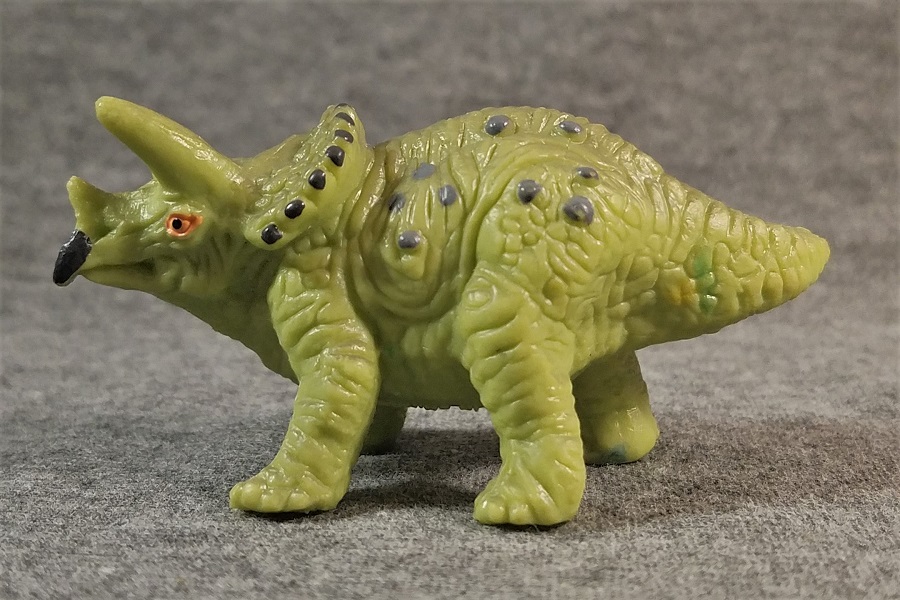
Triceratops is colored in mostly plain olive-green, with additional dirty brown/gray wash depending on the figure. Of my own two copies, the second is colored much more heavily gray, with more of a creamy belly. My first copy has individually-dotted scales on the body and frill; these are less evident on the second figure. Both versions have a black-tipped beak and bright orange eyes, which gives the figures a striking head-on appearance for their size. Some variation in the engraving of information on the belly is worth noting once again.
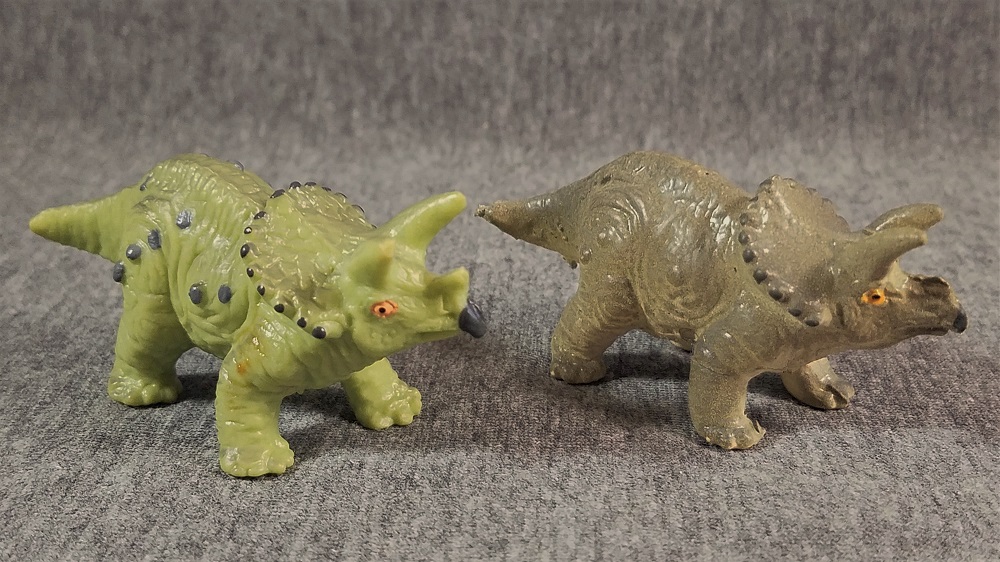
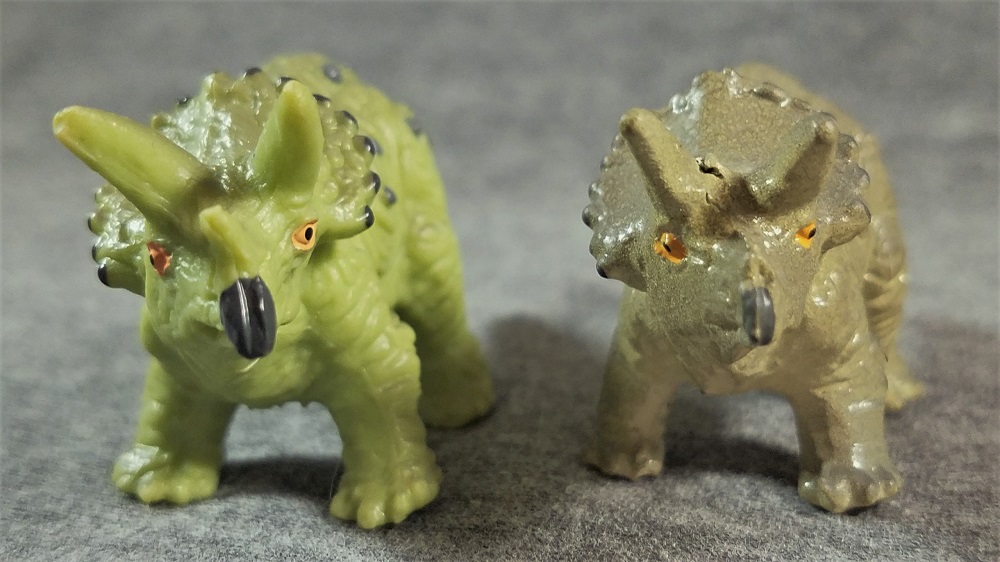
Forest Rogers was reportedly fairly new at sculpting when she started working for Safari ltd, so she undoubtedly had to learn a fair bit about designing products meant to serve as both museum-quality models and playable children’s toys. Rogers’ miniature figures look pretty dated today, but they manage to blend old-school science with more contemporary “personality” – which I think is the key to the charm of the Dinos I Authentics set as a whole. They remain fun to handle and display, and I think most kids would enjoy playing with these minifigures as much as they did 20 years ago (provided the kids are still playing with minifigures at all, at least). Safari ltd no longer sells the Authentics line, but they can often be found for reasonable prices on eBay and other 2nd-hand marketplace websites; and their legacy can also be found Safari ltd’s Dino Toob, which carries many of these core sculpts to this day.

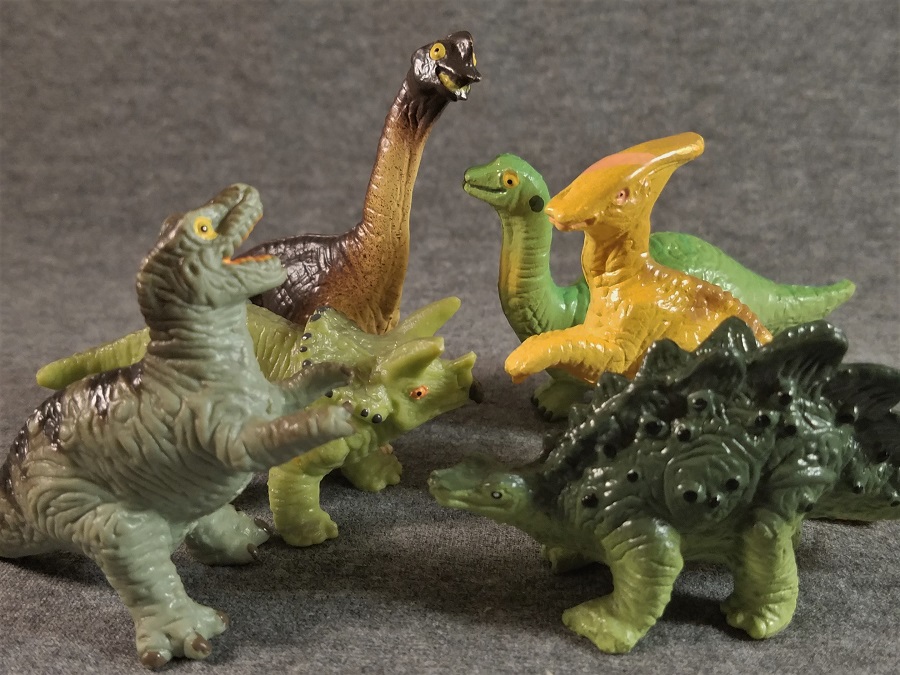
Support the Dinosaur Toy Blog by making dino-purchases through these links to Ebay and Amazon. Disclaimer: links to Ebay.com and Amazon.com on the Dinosaur Toy Blog are often affiliate links, when you make purchases through these links we may make a commission

Szerencsére megvan a T-rex meg a Stegosaurus.Jó cikk lett.Örülök,hogy írtál ezekről az aranyoságokról.Egyébként a második sorozatból több is megvan.
Brings back memories of the time I saw these guys way before I even started collecting. They surely are cute.
Five stars!!! I love Authentics figures and you can’t really chastise their quality given their size and the era they came out!
Great to finally see these on the blog. I had considered reviewing them myself but I don’t have the Apatosaurus. The Brachiosaurus is my favorite of the set, so stinkin’ cute!
I had several of these over the years, all now gone on to new homes. Happy times – thanks for sparking the old memories.
This is the blog’s 50th Brachiosaurus review!